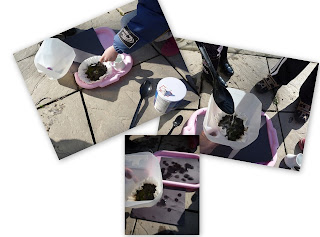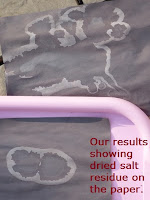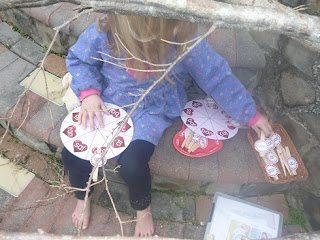Welcome to the Homeschool Den!

Before I had kids I used to teach high school history (and other subjects), but I sure don’t miss the stress or rush to get out the door. Our official (if you can call it that) school day usually starts around 10am with all of us gathering together for Collection–our group time. A lot of the time we start with a quick science experiment. Yesterday, for example, we were talking about why the ocean is salty. We went outside, got a shovel full of dirt, poured a couple teaspoons of salt on top of the dirt and then let it “rain” on the dirt. The water made its way down through the dirt and a coffee filter and we drizzled the water on black paper.
We let the paper dry out in the sunshine and came back in for our other subjects. As we walked back up the stairs to the house we talked about how pesticides and other chemicals get carried down from our lawn, into the creek and out into the larger river. All this only took about ten minutes, but we had some really good discussions as we did it.
According to one study by the National Home Education Research Institute there were over 2 million homeschoolers in the United States in 2010. (Just a few years earlier the Digest of Educational Statistics suggested there were 1.5 million homeschoolers in America.) The NHERI study suggests that 3.8% of K-12 students were homeschooled in 2010. (Up from the estimated 2.9% in 2007.) The homeschooling population continues to grow every year–estimates range from 2% to 8% each year. But you’ll find that homeschoolers are very different one another, just as every family is different. There are many different styles of homeschooling: classical, Charlotte Mason, Montessori, unschoolers and on and on. Many families pick and choose what works best for their child; they are referred to as eclectic homeschoolers. I suppose that is what we are. We follow a more classical approach when it comes to history (in general, we’ve studied history from the beginning and have moved forward in time. This year we’re on American History.) We pull in a lot of Montessori activities for science and geography. We use a variety of sources for language arts.
A couple of weeks ago, I had a long chat with a friend of mine who is a special ed teacher at a public school nearby. She had a lot of the normal questions we get. Are our kids getting enough socialization? My answer? Yes, in fact we have to be careful to make sure we keep our schedule clear enough to get our school work done. My kids do a group music class, play sports and dance, and get together with others regularly at the park, roller skating, or at other people’s homes. The kids do a lot of activities and have lots of friends. I strive to make sure they are polite, don’t interrupt and follow the rules just as kids in a classroom setting would. I guess we do differ in that my kids are allowed to talk freely and do not have to wait til they are called upon to interject a comment or make an observation. Personally, I see this as a plus.
My friend also wanted to know what subjects we cover. I’m fairly traditional so my kids have to do math, language arts/writing (spelling, narration, writing, grammar and so forth) and reading daily. As you’ll see we do usually have a couple of other units going too. Right now we’re studying the American West, the Arctic and are doing science experiments.

We hope you’ll stop in to visit us as we continue sharing our homeschool adventures.


























































Congratulations! I look forward to following you at your site’s new location!
Looking forward to reading more of your inspiring post over here. I have to say I always get real giddy whenever I see one of your pin maps:) Congratulations!
Looking forward to reading more of your inspiring post over here. I have to say I always get real giddy whenever I see one of your pin maps:) Congratulations!
Congrats! Love the look of your blog.
Congrats! Love the look of your blog.